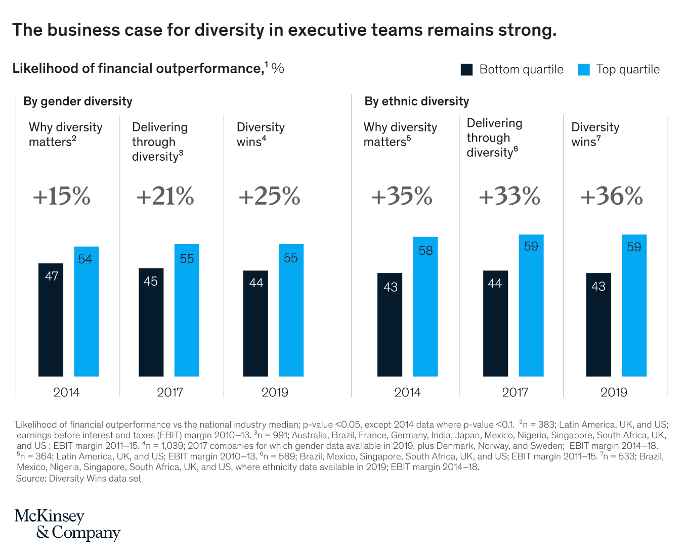Top 4 team building games about diversity and inclusion (activities for virtual teams included!)
Why diversity and inclusion matters in the workplace
Diversity and inclusion for teams always wins. There’s never been a stronger case to ensure that your team acknowledges and celebrates diversity and inclusion. Research from McKinsey shows that diverse teams consistently perform better. Teams that are diverse, whether based on gender or ethnicity, are expected to financially outperform by 25-35%+, than if they were not diverse. Having different viewpoints mean that your team is better able to adjust in an everchanging environment and it can be a company’s competitive advantage.
How can we promote diversity and inclusion in the workplace?
Diversity and inclusion is important, but it may not always be easy to figure out how to best promote it in the workplace.
Here are some of our favorite ways to promote diversity and inclusion in the workplace:
Organize diversity and inclusion team building events
Acknowledge differences, and highlight the strength it brings to your team
Celebrate holidays of all cultures
Seek to build a team that’s diverse
Educate your managers about why diversity is important
Create opportunities for your employees to engage with diversity in a meaningful way
Conduct diversity and inclusion ice breakers
For virtual teams, it’s even more important. When your team is remote or distributed, they’re not sitting side-by-side with their co-workers and it can be even more difficult to understand who an individual is beyond your regular work meetings or emails. Diversity activities for virtual teams may feel intimidating to figure out, but we’ve got you covered below with ideas on how you can conduct any of the below activities for a virtual or remote team.
The benefits of team building games for promoting diversity and inclusion
For your diverse team to perform at their best, you need to ensure that you have an open, understanding, and accommodating environment. One great way to help facilitate a welcoming environment is by hosting diversity and inclusion team building activities. Many managers that we speak to let us know that it’s difficult to know what the best team building games about diversity and inclusion are, so we’ve done the hard work for you. Below are our top 4 diversity and team building activities, with virtual options as well for those with remote or distributed teams.
1. Who Am I? game
2. Diversity and inclusion trivia
3. Privilege for Sale activity
4. Hometown Potluck
1. Who Am I? game
This is one of our favorite diversity and inclusion ice breakers. The objective of a “Who Am I?” game is to encourage empathy and understanding by encouraging team members to think about and share their personal experiences.
In order to facilitate this game, make sure to have sticky notes and pens. If you’re playing this game virtually, you can use an online answer form like Google Forms in order to anonymously collect everyone’s answer submissions virtually.
To play the game, each team member writes down a personal experience that has shaped their identity, but they do not put their name on the note.
The notes are collected and shuffled, and then re-distributed out to the team members.
Then, for the next 5-10 minutes, the team members stick the note on their forehead, without reading what’s written on it. They walk around and ask yes/no questions to figure out what’s written on their note.
For a virtual version, ask team members to anonymously receive their note and put it up as their virtual background, without reading in detail what it says. Then, when everyone is on the Zoom, instruct players to hide their self view (this is an option in the top right corner in Zoom) so that they don’t see what their own virtual background says.
When time is up, everyone can read what was written on their note, and ask them to share a reflection about their experience with the group. Finally, you can ask them to also share what they feel they’ve learned about each other. They just spent 10 minutes living in the shoes of one of their coworkers, creating empathy and understanding.
2. Diversity and inclusion trivia
Trivia is one of the best ways to educate a group in a fun and engaging manner. By nature of the trivia format, it creates discussion around topics and participants will leave the session having learned something new. At Bar None Games, trivia is an activity that we frequently facilitate, whether virtual trivia or in-person or hybrid trivia, and we’ve seen it as an extremely effective way to celebrate and engage with diversity and inclusion topics.
The goal of a diversity and inclusion trivia event is to encourage discussions and highlight facts that your team may not already know. You can also include a high-energy competition to make the event engaging, which helps people remember the facts that they learn during the event. Because trivia is a team-based experience, this is also a great diversity and inclusion ice breaker activity to help new team members feel comfortable and form connections.
To create an engaging and collaborative trivia experience, we recommend that you use a team-based trivia format, where your larger group is split into smaller groups. This creates space for thoughtful discussion around the trivia questions, and in a smaller setting, allows for a friendlier environment where people may be more open.
Focus the trivia content around one specific topic. Throughout the year, various months are chosen to highlight specific communities. These are great times to celebrate and honor these diverse groups. We have a list here of all of our favorite workplace holidays, including many which are diversity-focused. Whether you’re looking to celebrate Black History Month, Women’s History Month, Mental Health Awareness Month, AAPI Heritage Month, Pride Month, Hispanic Heritage Month, or more, these are all great topics to design a trivia event around. You can cover topics such as the history of the community, the accomplishments and impacts on society and the world by members of the community, and traditions.
3. Privilege for Sale activity
Many have heard of the Privilege Walk activity where participants step forward or backwards based on prompts around privilege, but have you heard of the Privilege for Sale activity? In this activity, instead of depending on people to have vastly different experiences to create a stark learning opportunity, this creates powerful learning without requiring your employees to have personal disclosure, which not all employees may be comfortable with.
In order to participate in Privilege for Sale, make a list of various privileges and write them on pieces of paper. If you’re conducting this virtually, you can use a tool like Miro to set up a board with all the options. Then, split everyone up into smaller groups of around 4 people per group. For virtual events, you can use Zoom’s breakout room in order to facilitate. Make sure to have a variety in the types of privileges that you include (social, financial, familial, and more).
For each of the groups, let them know that each privilege is $100. They have a specific dollar budget and they need to decide how they want to spend that to buy back privileges. You can choose anywhere from $500 - $1,000 for the total budget, depending on how many prompts you have, as long as the total budget is less than what the total cost of all of the privileges would be.
The group has five minutes to work out which privileges they would like to purchase. Through this, they’ll discuss what each privilege means and, subsequently, what lack of access to that privilege also means. It will also highlight to individuals what privileges they may have that they take for granted.
At the end, bring everyone back together to discuss as a larger group what their reflections were from the activity.
4. Hometown potluck
Food is a key part of anyone’s culture, and a potluck is a great way to share a meaningful recipe.
To facilitate this, you can either ask everyone to cook a dish that has personal meaning to them, or give everyone a budget for which they can purchase or cater a dish that’s meaningful.
Before everyone starts digging in, have the group go around to share what dish they brought in and why. The food we have cherished memories of can tell a lot about the diverse backgrounds that individuals have.
For remote teams, you can have people cook their favorite meal for themselves, and still have everyone go around in a circle to share why that dish is meaningful to them.



